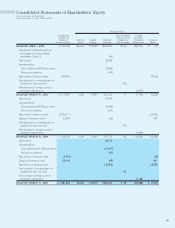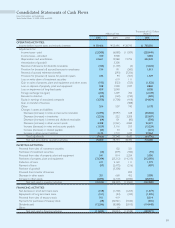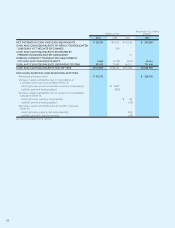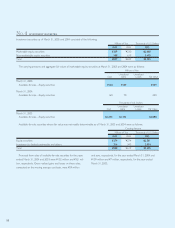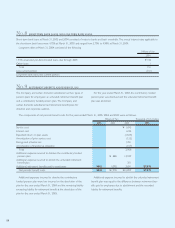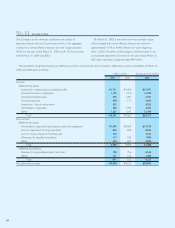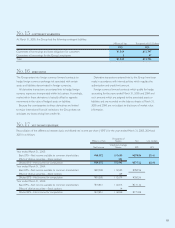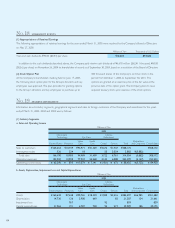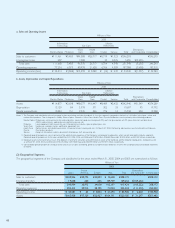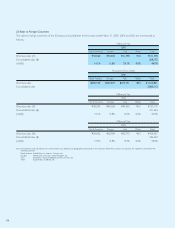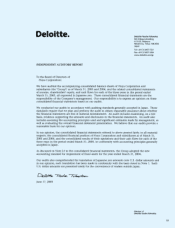Pentax 2005 Annual Report Download - page 62
Download and view the complete annual report
Please find page 62 of the 2005 Pentax annual report below. You can navigate through the pages in the report by either clicking on the pages listed below, or by using the keyword search tool below to find specific information within the annual report.
59
Japanese companies are subject to the Code.
The Code requires that all shares of common stock are
recorded with no par value and at least 50% of the issue price of
new shares is required to be recorded as common stock and the
remaining net proceeds as additional paid-in capital, which is
included in capital surplus. The Code permits Japanese companies,
upon approval of the Board of Directors, to issue shares to
existing shareholders without consideration as a stock split. Such
issuance of shares generally does not give rise to changes within
the shareholders’ accounts.
The Code also provides that an amount at least equal to 10%
of the aggregate amount of cash dividends and certain other
appropriations of retained earnings associated with cash outlays
applicable to each period shall be appropriated as a legal reserve
(a component of retained earnings) until such reserve and addi-
tional paid-in capital equals 25% of common stock. The amount of
total additional paid-in capital and legal reserve that exceeds 25%
of the common stock may be available for dividends by resolution
of the shareholders. In addition, the Code permits the transfer of
a portion of additional paid-in capital and legal reserve to the
common stock by resolution of the Board of Directors.
The Code allows Japanese companies to repurchase treasury
stock and dispose of such treasury stock by resolution of the
Board of Directors. The repurchased amount of treasury stock
cannot exceed the amount available for future dividend plus
amount of common stock, additional paid-in capital or legal
reserve to be reduced in the case where such reduction was
resolved at the shareholders meeting.
The amount of retained earnings available for dividends under
the Code was ¥135,550 million ($1,266,822 thousand) as of
March 31, 2005, based on the amount recorded in the Company’s
general books of account. In addition to the provision that
requires an appropriation for a legal reserve in connection with
the cash payment, the Code imposes certain limitations on the
amount of retained earnings available for dividends.
The general shareholders meeting held in June 2003 approved
the introduction of the Committees System stipulated in the
Code. Before the Committees System was introduced, dividends
had been approved by the general shareholders meeting held sub-
sequent to the fiscal year to which the dividends were applicable.
After introducing the Committees System, dividends may be paid
upon resolution of the Board of Directors, subject to certain limi-
tations imposed by the Code. Semiannual interim dividends may
also be paid upon resolution of the Board of Directors, subject to
certain limitations imposed by the Code.
On June 18, 2004, June 20, 2003 and June 21, 2002, the
Company’s shareholders approved a stock option plan for the
Group’s directors and key employees. Under the plan, 1,076 thou-
sand options were granted to them to purchase shares of the
Company’s common stock during the exercise period from
October 1, 2005 to September 30, 2009, from October 1, 2004
to September 30, 2008 or from October 1, 2003 to September
30, 2007. The options were granted at exercise prices of ¥10,850,
¥9,750, ¥6,690 or ¥7,670.
No. 10 SHAREHOLDERS’EQUITY
Assumptions used for the year ended March 31, 2003 were set forth as follows:
2003
Expected rate of return on plan assets 5.5%
Amortization period of prior service cost 12 years
Recognition period of actuarial gain/loss 12 years
Amortization period of transitional obligation 15 years
Remaining balances of prior service cost, actuarial gain/loss
and transitional obligation were charged to income when the con-
tributory funded pension plan was dissolved and the unfunded
retirement benefit plan was abolished in the year ended March
31, 2003.
Accrued retirement benefits for directors and corporate audi-
tors of the Company and its domestic subsidiaries were paid sub-
ject to approval of the shareholders in accordance with the Code.
The Company and its domestic subsidiaries abolished the retire-
ment benefit plan for directors and corporate auditors for the
year ended March 31, 2004.


